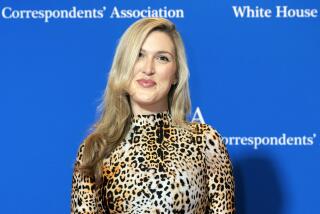Generational Rivalry Sparked Media Hostility : Competition: Peer pressure between younger reporters and veterans forced each side to avoid slightest appearance of being soft on Clinton.
- Share via
Early in the 1992 campaign, Garry Trudeau drew a series of “Doonesbury” cartoon strips ridiculing the media’s seeming fondness for Bill Clinton. For most of the campaign, the New Republic regularly featured a “Clinton Suck-Up Watch” that highlighted particularly egregious examples of media fawning over the Democratic candidate.
It is probably no wonder then that when Clinton was elected and many reporters who had covered him on the campaign trail were assigned to the White House, they encountered resentment from some longtime correspondents who thought they had been too soft on him.
Although it is common for some longtime White House reporters to worry that new competitors will have the best sources, developed over many months on the campaign trail, the journalistic rivalry in the Clinton White House was far greater, at least at first, in part because of generational differences between the two groups of reporters but above all because of this resentment. Indeed, the resentment produced a conflict that helps explain the hostile coverage the new Administration received almost from the day it took office.
Some veteran White House reporters seemed determined to prove that they could be tougher than the campaign reporters had been. The former campaign reporters, new to the White House, were equally determined to prove that they were not really patsies.
The Old Guard reporters are like a “permanent occupying force,” and they treated the new Administration and newcomers to the White House pressroom with equal contempt, like “a bunch of amateurs,” says Mark Miller, who covered the Clinton campaign and the first four months of his presidency for Newsweek.
White House reporters were “definitely . . . the source of the friction” that quickly developed between the Administration and the media, says George Stephanopoulos, now a senior adviser to the President.
Many newcomers tried to be just as tough on Clinton as the veteran reporters were to avoid being stigmatized as “starry-eyed” sycophants for the new President, “thereby confirming the suspicion that the press is liberal and apt to be taken in by people who are their contemporaries,” says David Lauter, who covered the Clinton campaign and is a White House correspondent for the Los Angeles Times.
Miller says reporters from the campaign “felt this pressure not to say anything complimentary (about) . . . the President . . . this general peer pressure to be mean and nasty and beat up on him like everyone else. If you dared say anything complimentary, you were . . . looked at like some sort of pathetic fool who was obviously in the tank.”
Other forces also drove the negative coverage by the newcomers, some of whom had viewed the Clinton campaign--led by its Rhodes scholar/policy wonk candidate--as “idea-driven.” They tried to cover the campaign and the Clinton White House with that thought in mind, says Adam Nagourney, who has reported on the Clinton campaign and presidency for USA Today. When Clinton began to compromise and retreat, they became disenchanted with what they saw as business--politics--as usual.
Perhaps more important, some reporters felt a “personal connection with Clinton,” Miller says. “For political reasons, for reasons of generation, they felt some kinship with him.”
Linda Douglass, a Washington correspondent for CBS News, says this generational affinity may have triggered a sibling rivalry in some members of the press corps, leaving them resentful that they were stuck in the pressroom while their peers on the Clinton team had the reins of real power.
More likely, Miller says, when Clinton began to stumble, his generational allies in the press corps felt a “sense of personal betrayal (that) was very apparent and that affected the coverage.”
“A lot of people thought that he had lied, and therefore they were going to be tougher on him,” he said.
Tom Brokaw, anchor of “NBC Nightly News,” is one of several journalists who compares the media’s reaction to that of “a lot of jilted lovers.”
In the beginning, reporters who came from the campaign helped their colleagues and editors understand the Clinton White House.
When Vincent Foster, the deputy White House counsel, was found dead, R.W. Apple, Washington bureau chief for the New York Times, called Gwen Ifill, who had covered Clinton for 18 months during the campaign and is now one of the paper’s three White House correspondents.
Ifill knew all the people around Clinton and Foster, “all the texture, all the linkage, everything,” Apple says, so he called her instead of Thomas L. Friedman, the paper’s two-time Pulitzer Prize-winning reporter, who also covers the White House, after having covered the State Department, and who has done some of the best, most insightful reporting on Clinton of anyone in the press corps.
Many longtime White House reporters are bright and talented, though--quick learners with a historical perspective the newcomers lack. Some have reported on and interpreted Clinton for their readers, viewers and listeners with as much or more insight than the campaign reporters.
Over the last eight months, in fact, the differences in the two groups have blurred considerably, tensions have diminished, and they all seem to have become susceptible to the larger forces at play in the White House press: Competition. Ego. Knee-jerk cynicism. The race to be first. Pack journalism.
No wonder Curtis Wilkie of the Boston Globe once described the White House pressroom as “the only day-care center in America Ronald Reagan hasn’t abolished.”
More to Read
Get the L.A. Times Politics newsletter
Deeply reported insights into legislation, politics and policy from Sacramento, Washington and beyond. In your inbox three times per week.
You may occasionally receive promotional content from the Los Angeles Times.










